The sun & andes andean Northwest
High peaks, geological formations, plateaus, deserts, indigenous villages, pre-Columbian ruins
When the nature becomes spectacle...
High peaks, geological formations, plateaus, deserts, indigenous villages, pre-Columbian ruins
When the nature becomes spectacle...
It includes a large area that includes the provinces of Jujuy, Salta, Tucumán, Santiago del Estero, Catamarca and La Rioja. The best seasons to visit it are autumn, winter and spring, i.e. from March to December, during which the climate is mild during the day and cool at night. With a couple of hours by plane from Buenos Aires you can reach any of the provincial capitals; from there, the best way to get around is by land with a car.
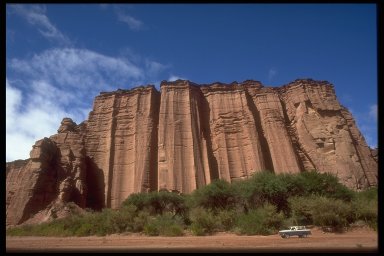 It is the area richest in pre-Columbian ruins, there are many well-preserved archaeological sites.
Rock art dates back to sedentary settlements, while bronze work in some areas shows strong Inca influence. Following it, the natives adapted to Spanish culture and religion, while preserving their languages (Quechua, Aymara), traditions, holidays and dances. This area has therefore become a pleasant colorful mixture of colonial architecture and folkloristic customs.
It is the area richest in pre-Columbian ruins, there are many well-preserved archaeological sites.
Rock art dates back to sedentary settlements, while bronze work in some areas shows strong Inca influence. Following it, the natives adapted to Spanish culture and religion, while preserving their languages (Quechua, Aymara), traditions, holidays and dances. This area has therefore become a pleasant colorful mixture of colonial architecture and folkloristic customs.
In the province of La Rioja, 260 km from the capital, it is possible to travel along the sandy banks of the river of the magnificent Valle de Talampaya canyon. It is a still virgin geological, archaeological and anthropological reserve, unlike that of Valle de la Luna 40 km away.
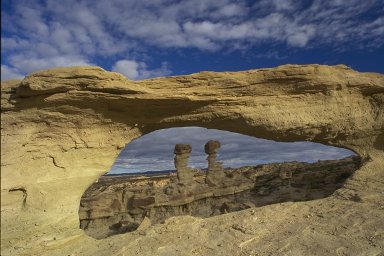 The area is full of paintings and engravings on the rock: anthropological figures, spirals, imprints of human feet with six toes and birds with strange wings. Furthermore, on the almost 200m walls you can see the different stratifications due to the geological eras. Upon request, you can visit the "Ciudad perdida" area.
The area is full of paintings and engravings on the rock: anthropological figures, spirals, imprints of human feet with six toes and birds with strange wings. Furthermore, on the almost 200m walls you can see the different stratifications due to the geological eras. Upon request, you can visit the "Ciudad perdida" area.
In Tucumán, 1310 km away from Buenos Aires, the variety of landscapes with tropical forest, semi-arid deserts and rich flora and fauna enrich the region with enchanting places to visit, such as Tafí del Valle at 200 km, a vast amphitheater adorned with tall stone columns erected by the Indians in the magnificent valley surrounded by the highlands. Don't miss the Menhires Park.
Furthermore, the lush valleys and the beauty of its valleys and hills covered with lemon trees, a consequence of the mild climate and the suitable soil, contribute to the production of this citrus fruit, the second activity of the province which represents 90% of Argentine production and 40% of exports such as fresh fruit.
The Valles Calchaquies, in the provinces of Salta and Tucumán, are characterized by a semi-arid flora, geological foundations, ancient stone sculptures, churches from the colonial period, regional products and important vestiges of indigenous culture, among such as the astonishing Ruinas de Quilmes, from the 10th century.
The city of Salta, 1620 km from Buenos Aires, has the best colonial architecture heritage in the country.
Located in a very fertile valley, it preserves buildings from the 18th and 19th centuries, such as the Cabildo, the Cathedral, the archbishop's palace, the Church of San Francesco and the convent of San Bernardo, the Monument to the fallen in the battle of Skip. The local craft market is interesting.
Climbing the mountain roads you reach the well-preserved ancient city of Cafayate, the southern entrance to the Calchaquies valley 200 km from Salta, where the "Torrontes" wine is produced, the only typical variety of the country. Worth visiting is a cellar with wine tasting and Rodolfo Bravo's private museum, rich in ceramics and fabrics from the pre-Inca period. We then reach Molinos and Cachi or Santa Rosa de Tastil, an archaeological site.
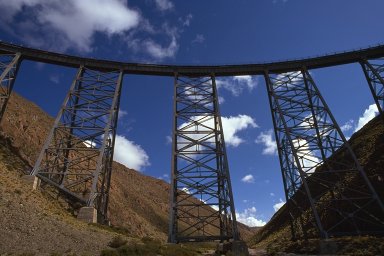 A breathtaking excursion from Salta to San Antonio de los Cobres can be achieved by taking the Tren a las nubes (Cloud Train), which runs on a railway built on top of a gigantic metal structure that reaches up to 70 meters high from the ground and 4,220 meters above sea level, operating only on Saturdays all year round. The journey, 434 km long, starts from Salta and lasts 14 hours round trip, crossing 29 bridges, 21 tunnels, 13 viaducts.
A breathtaking excursion from Salta to San Antonio de los Cobres can be achieved by taking the Tren a las nubes (Cloud Train), which runs on a railway built on top of a gigantic metal structure that reaches up to 70 meters high from the ground and 4,220 meters above sea level, operating only on Saturdays all year round. The journey, 434 km long, starts from Salta and lasts 14 hours round trip, crossing 29 bridges, 21 tunnels, 13 viaducts.
It is possible to follow the same route and others, taking a safari with the possibility of closely observing wild animals, exotic vegetation, impressive landscapes, with MoviTrack, which organizes excursions of one or more days.
Although the origins of San Salvador de Jujuy date back to 1593, the architecture of the city is not colonial like that of Salta due to an earthquake that struck it in 1863. The historic center is around Plaza Belgrano overlooked by the Cabildo, the Cathedral - with its gold-laminated wooden pulpit, made by a Jesuit with the help of local craftsmen, which depicts several biblical scenes - and the Government House. Worth visiting are the artisan market, the Municipal Museum of plastic artists and the Museum of paleontology and minerals.
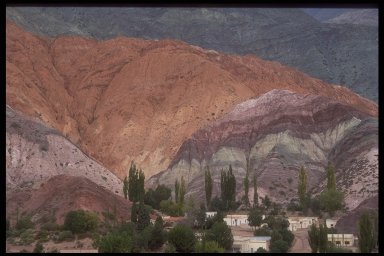 The Quebrada de Humahuaca, the road that passes through the Humahuaca gorge, whose most picturesque part is made up of the 80 km that connect Tumbaya - with a small colonial church in a characteristic style - to Humahuaca, is in the province of Jujuy. The valley is dotted with small villages and colonial churches. One of the most exclusive places is Purmamarca, at 2,192 m, born from an indigenous settlement, with the Cerro de los sei colores, (the mountain of seven colours), which reflect the different ages of the earth starting from the Precambrian period -570 million years ago - and its chapel which stands out against the ocher background of the mountains, the formations on the eastern Iruyalate of the valley called La Paleta del Pintor in Maimarà, the famous Pucará de Tilcara - an indigenous fortress from the 10th century. - where the Coya Indian market takes place, and Humahuaca, a town located at the bottom of the valley, with cobblestone streets founded in 1591 by a settlement of indigenous Omoguacas. From here it is possible to reach, by bus or by car, the small town of Iruya where it is possible to see women working with vicuna wool using artisanal methods.
The Quebrada de Humahuaca, the road that passes through the Humahuaca gorge, whose most picturesque part is made up of the 80 km that connect Tumbaya - with a small colonial church in a characteristic style - to Humahuaca, is in the province of Jujuy. The valley is dotted with small villages and colonial churches. One of the most exclusive places is Purmamarca, at 2,192 m, born from an indigenous settlement, with the Cerro de los sei colores, (the mountain of seven colours), which reflect the different ages of the earth starting from the Precambrian period -570 million years ago - and its chapel which stands out against the ocher background of the mountains, the formations on the eastern Iruyalate of the valley called La Paleta del Pintor in Maimarà, the famous Pucará de Tilcara - an indigenous fortress from the 10th century. - where the Coya Indian market takes place, and Humahuaca, a town located at the bottom of the valley, with cobblestone streets founded in 1591 by a settlement of indigenous Omoguacas. From here it is possible to reach, by bus or by car, the small town of Iruya where it is possible to see women working with vicuna wool using artisanal methods.
Throughout the region you can appreciate the tasty local food, the rhythmic Andean music with dances, the excellent silver craftsmanship and the excellent hospitality of the local people.
Aconcagua and its wines
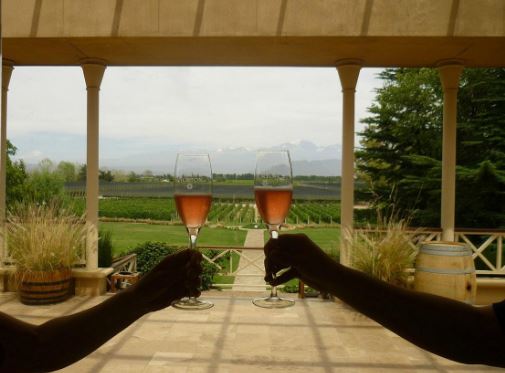 Mendoza, San Juan and San Luis, the three provinces that form the Cuyo region ("Sand Country" in the language of the Mapuche Indians), are located an hour and a half's flight from Buenos Aires. This area, at the foot of America's highest mountains, is famous for its wines, high peaks and winter tourist attractions.
Mendoza, San Juan and San Luis, the three provinces that form the Cuyo region ("Sand Country" in the language of the Mapuche Indians), are located an hour and a half's flight from Buenos Aires. This area, at the foot of America's highest mountains, is famous for its wines, high peaks and winter tourist attractions.
Cuyo's skies are virtually always clear, no matter what time of year. Winters are mild and dry, except in the highest areas, and summers are hot.
Mendoza and San Juan produce 90% of Argentina's wines, which is the fourth largest producer in the world. The dry climate and cold winters favor the growth of vineyards; this industry is also a tourist attraction throughout the year, but especially in the harvest season (from February to the end of April) which reaches its highest point with the Festival de la Vendimia in Mendoza. Today it is also a rich oil region.
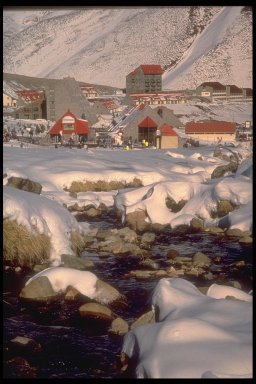 The sports that can be practiced are Andean skiing on Aconcagua, which with its 6,959 m. it is the highest peak in America, and on the Tupungato volcano, 6,800 m., carrovelism at the foot of the mountains, trekking and horse riding throughout the area.
Las LeñasSkiing can be practiced in Los Penitentes and Las Leñas, the most modern ski resorts in the region.
The sports that can be practiced are Andean skiing on Aconcagua, which with its 6,959 m. it is the highest peak in America, and on the Tupungato volcano, 6,800 m., carrovelism at the foot of the mountains, trekking and horse riding throughout the area.
Las LeñasSkiing can be practiced in Los Penitentes and Las Leñas, the most modern ski resorts in the region.
In the city of Mendoza, 1000 km from Buenos Aires, various museums bear witness to the important history and cultural life of the city: the Museo Histórico San Martín contains documents and objects belonging to the "Libertador" and the War of Independence, the Museo de Ciencias Naturales y Antropológicas, dedicated to archaeology, paleontology and anthropology, and the Museo Arqueològico with an important collection of pre-Columbian ceramics. It is possible to visit and taste wine in one of the cellars (bodegas) that surround the city.
To the west of the province two roads lead to Uspallata, one of the richest mining districts in Argentina during the 18th and 19th centuries - you can still see the old mines - in the center of a valley that stretches between mountains and hills. It can be reached by crossing Villavicencio, surrounded by the highest peaks of the regions, where the condor lives, or by passing through Cacheuta, a well-equipped spa place on the Mendoza river where fossils of prehistoric animals and ruins of indigenous settlements have been found.
Along the road to the Andes is the Los Penitentes ski resort; Puente del Inca, an eroded rock formation used for the passage of Indian caravans, and the pass to Chile, Las Cuevas, after passing the statue of Christ the Redeemer at an altitude of 4200 m.
To the south are the petrified forests of Llano Blanco with the fossilized remains of araucarias and the ski resort of Las Leñas, with 33 ski slopes for a total of 65 km and a 25 km cross-country ski track, with excellent infrastructure at various levels, it is very popular not only during the ski season, from June to the end of October, but also during the rest of the year by those who want to practice paddle, tennis, horse riding and fishing.
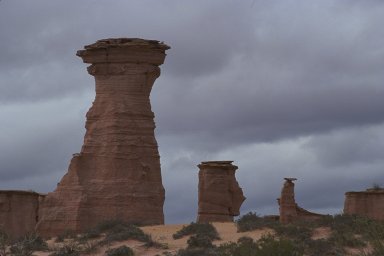 In the province of San Juan, one of the driest in Argentina, there are the thermal springs of Pismanta and the largest reserve of vicuña, a wild animal in the region whose wool is highly prized.
In the province of San Juan, one of the driest in Argentina, there are the thermal springs of Pismanta and the largest reserve of vicuña, a wild animal in the region whose wool is highly prized.
It is definitely worth visiting, with its strange lunar landscape carved out by erosion, the Ischigualasto Provincial Park, better known as the Valle de la Luna, a large depression where there was a lake millions of years ago. It has the same geological conformation as Talampaya in the province of La Rioja 40 km away. Fossils of plants, trees and animals remain from that period; the remains of dinosaurs from 230 million years ago were found here. Today you can observe the different layers corresponding to the different geological eras, and capricious rock formations due to wind erosion.